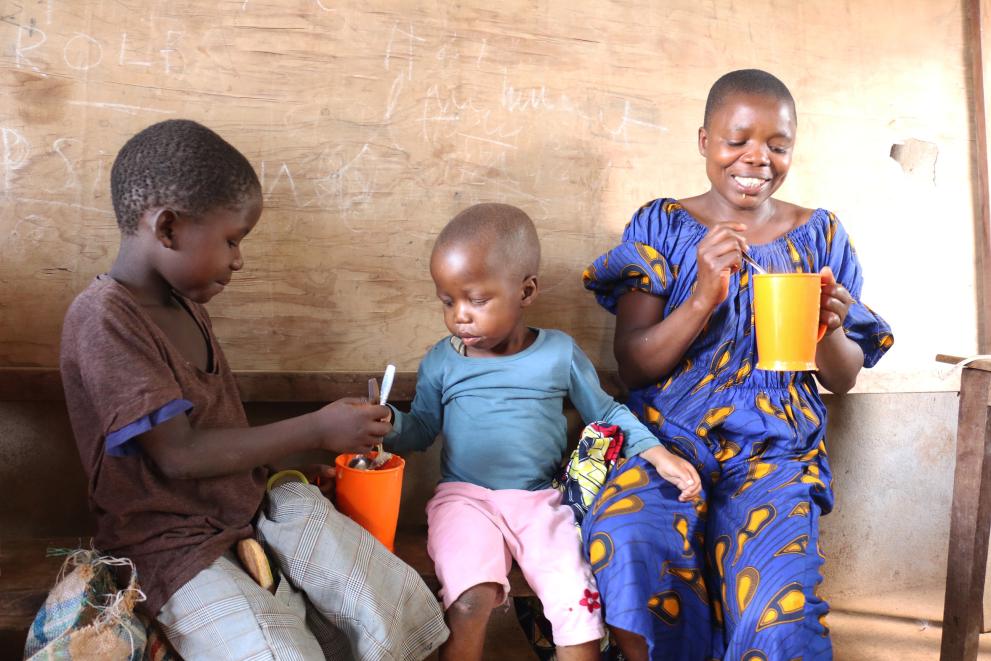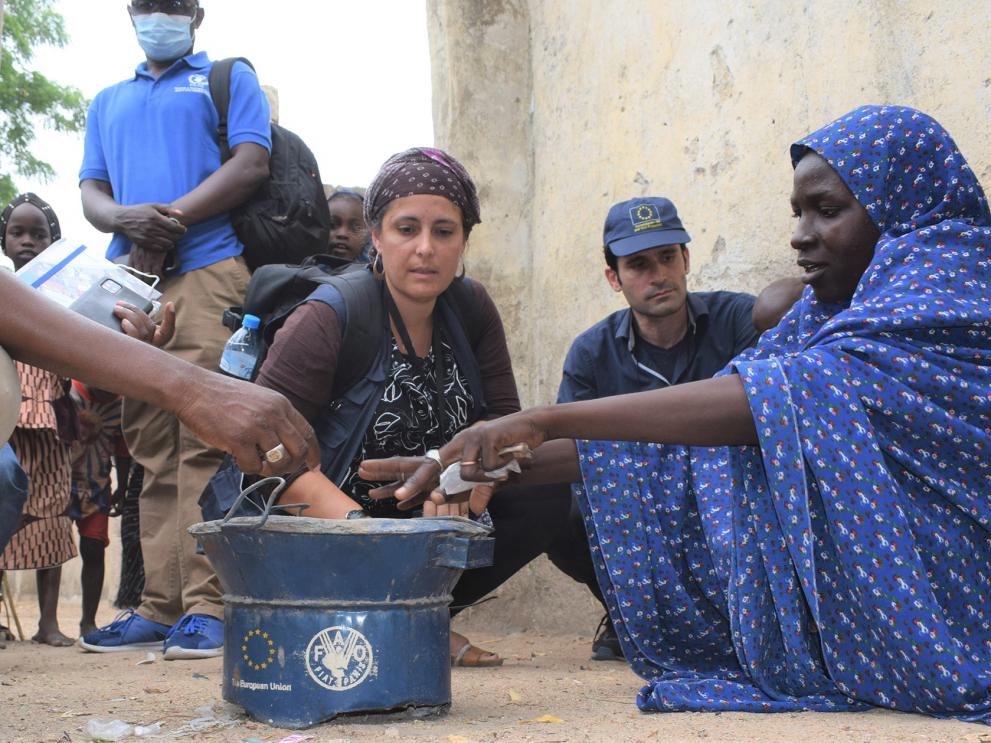What is it?
The EU provides food assistance in anticipation of, during, and in the aftermath of a humanitarian crisis. It aims to save lives and livelihoods by averting widespread hunger.
Through its humanitarian food assistance, the EU aims to ensure access to safe and nutritious food for the most hungry and vulnerable people in crises.
Why is this important?
In 2022, food insecurity reached unprecedented levels in scale and severity, reaching the highest level on record since the start of the collection of data for the Global Report on Food Crises (GRFC). 1 year later, the report shows no improvement, with 281.6 million people in 59 countries/territories facing acute food insecurity in 2023.
In 2023, 5 countries had populations in IPC/CH Phase 5 (catastrophe), the highest on the scale: Gaza, Burkina Faso, Somalia, South Sudan, and Mali, totalling over 700,000 people – the highest number in GRFC reporting history and almost double that of 2022. This figure has dramatically increased in 2024, with around 1.5 million people in IPC5.
Food insecurity has been following an alarming trend in recent years, mainly owing to conflicts, economic shocks, and climate change. The Global Report on Food Crises 2024 (GRFC 2024) identifies armed conflicts as the major driver of food insecurity: Sudan has faced the biggest deterioration due to the devastating impacts of the conflict since April 2023, with an additional 8.6 million people facing high levels of acute food insecurity, bringing the total to 20.3 million, and the highest number of people in the world facing emergency (IPC Phase 4) levels of acute food insecurity.
Moreover, the escalation of hostilities in the Gaza Strip in late 2023 created the most severe food crisis in IPC and Global Report on Food Crises’ history, with the entire population facing acute food insecurity. An IPC analysis published in March 2024 warned of a further deterioration with famine imminent between March and May 2024 in the northern governorates of Gaza and North Gaza, and a risk of famine across the rest of the Gaza Strip. Half of the population (about 1.1 million people) were estimated to be experiencing IPC Phase 5.
The timely and effective delivery of humanitarian assistance is at risk due to the simultaneous and sudden increase in needs and operational costs. UN agencies are warning of a worsening situation in the immediate future.
Despite the collective efforts, funding struggles to keep pace with growing food assistance needs. The consequences of the funding gap are being felt by partners and consequently by those affected by food crises.
Lack of appropriate funding implies hard prioritisation decisions contingent on difficult trade-offs, with partners forced to reduce the number of people assisted or reduce the quantity of assistance, or both.
This can easily lead to a vicious cycle where, for instance, a focus on assisting those facing starvation may come at the expense of others rapidly falling into the same category.
How are we helping?
The EU provides humanitarian food assistance to victims of food crises worldwide and invests in reducing the risk of famine.
Since 2010, the EU has been rolling out its humanitarian food assistance policy and has helped millions of people who lack access to sufficient quantities of safe and nutritious food.
Between 2021 and 2023, the EU used around 1/3 of its annual humanitarian aid budget to provide emergency food assistance and nutrition. This makes the EU one of the world's major donors in this area.
The EU is committed to helping the most vulnerable people affected by ‘forgotten crises’, allocating at least 15% of our initial annual humanitarian budget to these crises. Many of the worst food crises fall in this category, and in 2023, over 1/4 of the EU humanitarian food assistance (around €175 million) was distributed in such crises.
This includes some of our largest food assistance interventions in countries like the Democratic Republic of the Congo, South Sudan, Nigeria, Lebanon, Bangladesh, Burkina Faso, and Mali.
Some examples of the largest food assistance interventions in 2023
 The Democratic Republic of the Congo (DRC)
The Democratic Republic of the Congo (DRC)The EU allocated around €100 million to the humanitarian response to finance multi-sectoral projects, including around €31 million for food security and nutrition. In 2024, food assistance will remain one of the most important areas considering the critical needs in the country.
 South Sudan
South SudanThe EU allocated close to €28 million to food security and nutrition interventions in 2023, which represents 30% of the total humanitarian aid budget for South Sudan for that year. A similar proportion of the 2024 budget is expected to be allocated to food assistance and basic needs.
 Nigeria
NigeriaThe EU allocated around €16 million to food security and nutrition interventions in 2023. Considering the critical food security needs in the country, food assistance will remain one of the priority sectors. The EU is one of the leading voices in humanitarian advocacy in the northwest, an area affected by growing violence and food and nutrition crises.
EU food assistance is adapted to each specific crisis and the needs of different groups, for example, children under 5 years old. The EU provides the most vulnerable people with essential and nutritious food items during critical times.
A significant part of our food assistance is provided in the form of cash transfers. This is because sometimes there is enough food in shops and markets, but the victims of disasters cannot afford it. When this happens, the EU prefers helping vulnerable people get access to the food they need by giving them money to buy it. This is often more efficient and effective than shipping sacks of rice or flour across the globe.
For example, in South Sudan, the EU is financing a multi-purpose cash assistance action to meet the critical basic needs of flood and conflict-affected communities in the Jonglei and Unity states, implemented by Save the Children Denmark. This action, with a budget of over €6 million, has proved to be significantly more efficient compared to in-kind food distribution in the same country.
Whenever possible, the EU aims to provide sustainable solutions and restore self-reliance by building resilience and protecting the livelihoods of households at risk of food shortages. It does this in many ways, such as by giving seeds and toolkits to vulnerable family farmers so they can grow their own food and restore their livelihoods.
The European Commission is a member of the Food Assistance Convention and has committed to providing a minimum of €350 million annually to alleviate food insecurity. In the last 2 years, it has mobilised over €1.7 billion in emergency food and nutrition assistance for the most vulnerable countries.
The Commission is making every effort to maintain appropriate levels of funding, and to provide food assistance in more coordinated and efficient ways.
Last updated: 24/04/2024
Facts & figures
Over 281 million people in 59 countries were acutely food insecure in 2023.
Largest beneficiaries of EU-funded food assistance in 2023: Ukraine, Afghanistan, Sudan, Yemen, Syria, Democratic Republic of the Congo, South Sudan, Ethiopia, Palestine, Nigeria, Lebanon, Bangladesh, Chad, Burkina Faso, Mali.
Food and nutrition assistance accounted for around 28% of the EU’s total humanitarian budget in 2023.
Over 1/4 of EU humanitarian food assistance (around €175 million) was distributed in ‘forgotten crises’ in 2023.
EU humanitarian food assistance in 2023:
over €1 billion
Downloads
- 12 SEPTEMBER 2024
- 5 MARCH 2024
- 15 SEPTEMBER 2023
- 10 MAY 2023
- 17 FEBRUARY 2023
- 16 DECEMBER 2022
- 2 DECEMBER 2022
- 2 DECEMBER 2022

